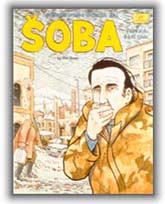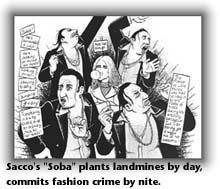| VOLUME 30, NUMBER 18 | THURSDAY, JANUARY 28, 1999 |
Into the 'comix' netherworld
Artist/writer Joe Sacco brings his award-winning work to UB
By PATRICIA DONOVAN
News Services Editor
Once upon a time, transgressive cultural discourse took place principally in union halls, on campuses or among tiny bands of artists, musicians and theater folks. For the past 60 years, however, it also has stalked the pages of comic books-not "Richie Rich" or "Archie," but the alternative and underground "comix" written and drawn by cartooning anarchists.
 The UB Art Gallery will offer a peek into the '90s version of this global netherworld with an exhibition of work by insurgent comic-book artist and writer Joe Sacco, whose award-winning documentary work has garnered praise far outside his field.
The UB Art Gallery will offer a peek into the '90s version of this global netherworld with an exhibition of work by insurgent comic-book artist and writer Joe Sacco, whose award-winning documentary work has garnered praise far outside his field.
The show will open tomorrow with a public reception for the artist from 7-9 p.m. in the University Gallery in the Center for the Arts. It will run through March 7. Sacco will lecture on his work at noon tomorrow in the Center for the Arts Screening Room. The talk is free of charge and open to the public.
'Cream of the crop' cartoonist
Sacco is considered one of the absolute cream of the crop of alternative and underground cartoonists. This tough-minded breed constitutes the political and artistic progeny of Jules Feiffer and Robert Crumb, the radical godfather of some of the most notorious "toons" published during the Silver Age of comic book art.
Joined at the brain, dastardly writers and cartoonists gleefully wing their brickbats from the cultural margins. That's where artists live.That's how you know they're artists. We duck, but sometimes they hit us right in the head with an appalling visual assault, then in the brain with an agenda destined to horrify young Republicans.
Like their predecessors, they use new styles of visual art and borrow old narrative forms-myth, legend, parable, and even Saturday morning cartoons-to make their point. Some stories are fantastical, some hilariously manic, some very gross. And some, like Sacco's, are deeply rooted in fact and about as "comic" as having your foot blown off by a landmine.
Comix to shock
The usual targets: hypocrisy, sexism, racism, power madness, our political allies, people who hate fat people, all manner of violence, viciousness, destruction and deceit-the comix shock, knock and mock. They also take aim at terrorism, fools, corporate greed, imperialist governments and life on the lower rungs of the capitalist order.
There admittedly is plenty of the usual sinew and women-flesh in these publications, and some authors write things that'd kill your dog with one sniff. All in all, however, there's a lot of "Zippy the Pinhead" (before he went legit) in them there racks.
Genealogically speaking, Sacco comes from the Art Spiegelman ("Maus," "Maus II") branch of the comic-book family, in that he practices "cartoon journalism." His stories, logged in pen and ink, have chronicled the struggle for an independent Palestine, war-mongering and the daily misery and horror of the Bosnian conflict and The Hague war trials.
Satire and personalization are loaded on top of piles of dead bodies and ruined cities. Sacco makes readers see what he sees-that good and evil are not exclusive categories; that we lie to ourselves about our own crimes; that humans of all races, creeds and nations murder one another every day, then slave to develop more and more efficient ways of doing it.
The sardonic voice of Sacco's comics (some, by the way, are collected and sold in bound versions) would make mainstream news publications wince and run. The comic-book genre, on the other hand, always has had a wicked edge the political right loves to hate. This is just its latest presentation.
Having traveled to Sarajevo to document the Bosnian war, Sacco wrote and illustrated five self-contained "Stories from Bosnia" that make chop suey of that nation's purveyors of violence men who weep when their own are slaughtered, then race to hop into their own sniper outfits. Critic Chris Hedges, writing in The New York Times, described Sacco's Bosnian drawings as "stark, realistic visions of the gray, depressing world of a land mangled by artillery shells and deformed by poverty."
Sacco conveys the banality of this particular evil by showing the same guys ("The Man Who Plants Landmines," "The Great Fighter") in cheesy outfits sweating through mating rituals at the local dance hall. Time after time, in nation after nation, he links deluded concepts of "manhood" with appalling acts of violence and cruelty.
Last year, Sacco's Bosnian stories were nominated for two 1998 Ignatz Awards-named after cartoonist George Herriman's brick-wielding mouse. The award is conferred by Small Publishers Expo for outstanding achievement in comics and cartooning. Sacco also received the comics industry's prestigious Harvey Award and an American Book Award in 1996.
Story of society in breakdown
 One of his latest books is "War Junkie," a collection of stories that chronicles a society in total breakdown. These are accompanied by Sacco's clear-eyed and what someone called "disturbingly honest personal narration of his own depression." This is an apt topic for comics, since clinical depression is thought by many to manifest the stress and horror of contemporary life.
One of his latest books is "War Junkie," a collection of stories that chronicles a society in total breakdown. These are accompanied by Sacco's clear-eyed and what someone called "disturbingly honest personal narration of his own depression." This is an apt topic for comics, since clinical depression is thought by many to manifest the stress and horror of contemporary life.
"War Junkie" was compiled from short and harrowing stories that had appeared in the periodicals Yahoo and Drawn and Quarterly. In meticulous line drawings and commentary, Sacco offers what one critic called "a whip-smart dialogue/travelogue on the Persian Gulf War, the civilian bombings of Europe and Japan in World War II, Libya and Malta."
His story "When Good Bombs Happen to Bad People" is a history of air warfare that targets civilian populations. The pictorial narrative is punched up with devastating real-life quotes from military and political leaders as it thrusts the savagery of this strategy to the forefront. It even has a bibliography and footnotes.
This show will feature work from Sacco's early Yahoo series (1988-92), several chapters of Palestine and several chapters from Soba, a 40-page book that opens his "Stories from Bosnia" series.
|
To place Joe Sacco in context, it is useful to review some of the popular titles in comic-book art. Many are richly drawn and colored, and expensively printed; others are speedy demons that appear for a few issues and disappear forever. Violent, antireligious, scatological, cute, tabloid-based-you name it, it's published by an independent press that has a relatively small, but rabid-audience. Comics Central in Buffalo is Queen City Books on Main Street, where you can take a comic-book thrill ride and listen to the regulars debate whether Batman is cooler than The Spawn. Remember the 'tooners in "Chasing Amy"? It's a brave new world out there. - "Minimum Wage Book 1" exposes the miserable lives of protoslackers who languish in low life scumhood. You won't like 'em but you'll recognize 'em on the bus. - "Fat Grrrl," comic series by cartoonist Nony Lamm, a young radical component of the "fat-acceptance movement," graphically catalogues and battles "fat prejudice." - "Candor," one in a series of true-life tales published by Dark Horse Press, features the enormously irritating Harvey Pekar, a nearly deranged hospital file clerk who lives out the insect-like existence of many low-range bureaucratic hairballs. Through his job, Harvey "witnesses" torture, murder, suicide, arson, child abuse and all manner of daily American mayhem, which he generously and graphically shares with his readers. - "Sake Jock Comicks" is a top-selling Japanese series marked by action accented with glimpses of dark, disturbing and confused aspects of Japanese life. - For real-life tales, check out the work of Dennis Eichorn ("Real Stuff," "Real Smut," "Real Schmuck"), a self-described former stud-wimp-jock-jailbird-bartender-bouncer-firefighter-substance abuser-rock 'n' roller-sinner and saint whose sordid doings are published by Cutting Edge Comix. - "Industrial Gothic" comics are constructed around a Rod Serling theme, a future in which perfection and beauty rule the day and the flawed are tossed into huge prisons. Hey, Joey, is dat a wen on your neck? - "The Revenge of Hothead Paisan" from Cleis Press features an eponymous homicidal lesbian terrorist (which is, by the way, the prevailing cultural definition of "lesbian") who offers catharsis for everybody, including men! - On the lighter and sweeter side, Slave Labor Press puts out "Action Girl"-a series of fun, girl-positive stories by mostly female comic-book writing stars. Boys allowed. - For rich, full, pseudo-realist art, look up the apocalyptic "Button Man," a book of tales of modern-day gladiators who kill for money in a fatal version of tag. These titles and many more can be found at http://www.alt culture.com.
|
Current Issue | Comments? | Archives | Search
UB Home | UB News Services | UB Today